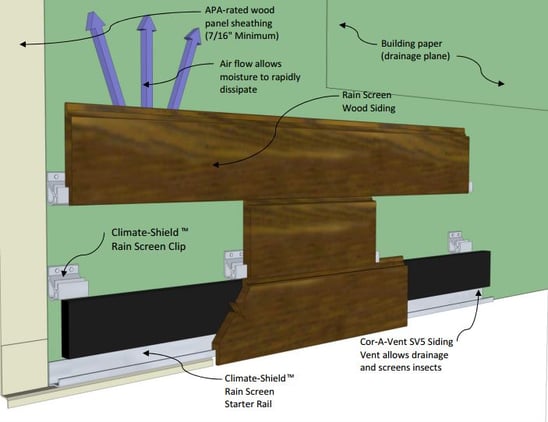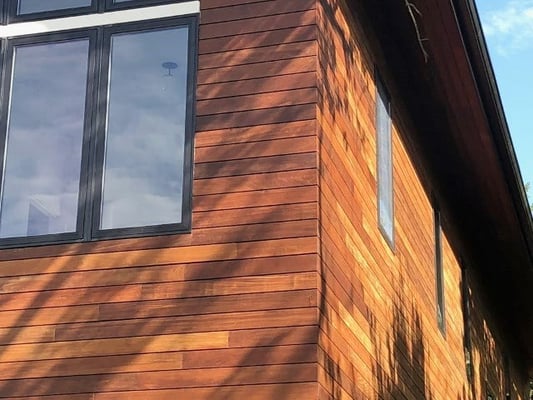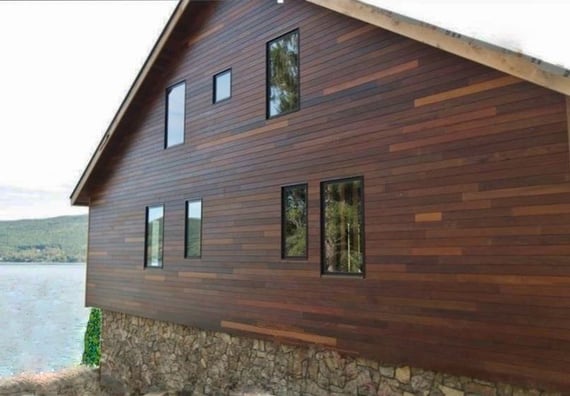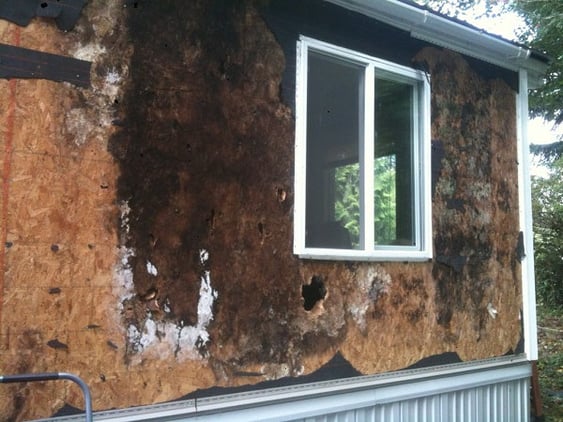
Wood rain screens are naturally beautiful. And they perform exceptionally well. If your clients know about them, they will likely want one on their home. If they don’t know about them, you should educate them. They deserve to know and so do you.
What is a Rain Screen and Why Should I Care?
A wood rain screen or “rainscreen” is a time tested, proven siding method to help your buildings last, and last, and last. How long? I’m not sure exactly, but this stave church in Urnes, Norway has been standing since the late 1100’s. We’ve been told it is the original siding.
A rain screen is basically a double layer of protection for a home or building. The siding ‘stands off’ the exterior wall. This keeps the rain and harsh weather elements outside, where they belong. Because the siding stands off the exterior wall, it creates a gap. The gap, or air space, is often called a wall cavity, or rain screen gap. This is where the magic happens. More about that later.
The rain screen gap is ventilated and that's what keeps the building dry. This is how you can minimize the potential for mold. This is why siding can last for decades, or even centuries. But only if the rainscreen works effectively, as a system. The building needs to ventilate from the inside, too. This allows indoor moisture to escape.
What is a ‘Wood’ Rain Screen?
There are many rain screen cladding materials; brick, metal panels, high density laminates, wood siding and more. A ‘wood’ rain screen is simply a rain screen system that uses wood siding for the cladding.
Attention Builders: Energy Codes are Important, But So Is Proper Ventilation
Nobody wants to spend a fortune to heat and cool their home. Builders take extra efforts to make their homes exceptionally tight. Insulate that home to keep energy costs down. Building code requires this. The problem nowadays is that homes are so tight, and so well insulated, they CAN’T breathe. Interior moisture remains trapped inside. No way out. Not good.
That's where a well designed rainscreen helps. How can a high-quality builder, designer or remodeler remedy this problem? A quality building wrap is the first place to start. A breathable ‘AWB’ (air and water barrier) that allows interior moisture to egress, but keeps outdoor moisture out, helps. But if the wood siding is attached directly to the wall, the moisture stays there. Uh-oh!
Mold remediation is a billion dollar industry. Don't help it grow.
Avoid Job Callbacks by Using a Rain Screen
The following story is a dramatization of real events. No names are used, to protect the innocent.
First, the paint starts peeling. The builders phone starts ringing. It’s the same customer that just last year, wrote a great Yelp review, named their first-born child after the builder and told him how much they love their new home. Now, they’re not feeling the love. Angry words are exchanged. The builder springs into action.
The painter gets the first call back. After an earful of browbeating, ‘you used cheap paint’, ‘you did a terrible job’ and other abuse, the painter skulks away from the home with his head hung low.
The paint supplier gets the next call back. She hears, ‘you sold me lousy paint’, “I’m never gonna use your paint again”, “you told me this paint would last 5 years”, and other joyful news. The paint supplier walks away from the home, sadly, and calls the manufacturer.
The paint manufacturer hears, “there must be something wrong with that batch of paint you sold us”. Then after 2 months, umpteen job site visits, laboratory testing and chemical analysis, determines there is nothing wrong with the paint.
Aha! It must be the siding. Next, the wood siding supplier gets the tongue lashing. And on and on and the finger pointing, and denials continue.
Somebody must take the blame. The inquiry is over, the verdict is in:
- The paint supplier sends new paint at no charge, because he doesn’t want to lose his customer, the painter.
- The painter re-paints the house at no charge to the builder, because he doesn’t want to lose his customer, the builder.
Then the siding starts to rot. A year later, the paint starts peeling again and the siding doesn’t look healthy. The customer has had enough. The builder has had enough. The wood siding supplier gets a threatening call from the builder. “You’re siding is rotting. You need to get out here (again). You better do something!”
Everyone meets once again at the job site. The mood is somber. All eyes are cast to the ground, like a burial. Mourning doves coo gently in the distance. The sky is gray. A sense of impending doom hangs in the air.
Oops. Somebody else must take the blame. Finally, the siding is removed. Wait! What the hell is that? That’s called mold. Aha! It must be the air and water barrier supplier’s fault. Let’s get them! Nope. The air and water barrier did its job. It allowed the moisture to pass from inside to outside, just like it should.
The problem was the wood was sitting directly on the building envelope. And wood loves water. Wood laps up water like a thirsty dog on a hot summer day. Unlike a dog, however, the wood keeps it water. There it feeds the mold. The mold rots the siding and turns it into a pulpy mess that closely resembles oatmeal.

A well-designed rain screen system protects your home, your client and your reputation
So, What’s the Lesson?
All these problems could have been avoided by using a rainscreen system. Houses need to ventilate. Wood needs to breathe. Putting siding directly on the exterior wall of a well-insulated and properly ventilated house doesn’t work anymore. Houses are simply too tight for this type of installation.
- Do you want your house to function properly, last long and keep your customers happy? Use a rain screen system.
- Do you want to build a hundred-year home? Use a rain screen.
- Are you a quality builder who cares about your clients? Use a rain screen.
- Do you hate expensive job site call backs? Use a rain screen.
If you are not up to speed on rain screen options, we can help. If you need tips and advice on rain screen installation, we can help you there too.
Download the Wood Rainscreen Project Design Ideas for more inspiration

Related Posts







